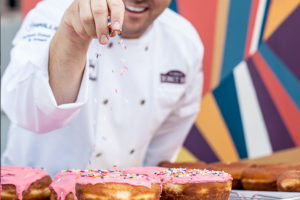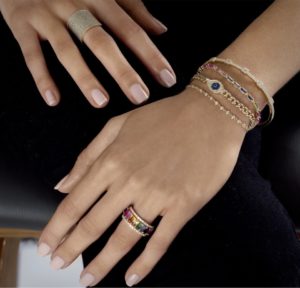When people interact with your brand, who are they talking to?
Brand personality is the tone, word choice, energy, and imagery that makes a brand feel more like a person and less like a product. Brand personality does three main things for a brand:
- Builds a relationship with your customer
- Makes a brand memorable
- Fosters trust and authenticity
Every interaction between your brand and the consumer makes an impression on them, for better or for worse. Take control by building a clear brand personality. Here are our tips to getting started:
1. Identify Your Customer’s Persona
To identify your customer’s persona, sit down with a pen and paper and deeply consider how your customer’s life circumstances affect how they feel about your brand. Consider these factors:
- Demographics – What is your typical customers’ age, gender, geographic location, education level, and income level?
- Lifestage – Parents, empty nesters, and college students have different motivations and desires. What life experiences is your target customer currently having?
- Lifestyle – Occupation, income, political opinions, and hobbies impact how someone’s day-to-day looks. What does your target customer’s typical week look like?
- Paint Point – Why is your customer in need of your product or service?What pain points are they currently experiencing?
Keep in mind – you might have more than one customer persona. Break your customers into groups if needed. A deep understanding of your customers is the foundation upon which brand personality is built, so whatever brand personality you develop needs to resonate with all of your core customer personas.
Get into the mind of someone interacting with your business online. Why are they on your website? How would they like to be spoken to? With your customer in mind, you can then pick what type of brand personality you want to emulate.
2. Familiarise Yourself With The “Big 5”
All excellent brands understand the basics. The “Big 5” are the five core brand personality dimensions: Sincerity, Excitement, Competence, Sophistication, and Ruggedness. This model was developed by behavioral scientist Jennifer Aaker and it cuts to the core of what consumers are looking for in a brand.
To make use of this model, read the statements below and determine which of these brand personalities best embodies your business.
- Sincerity – Sincere brands are down-to-earth and emphasize their honesty. Family-oriented brands often use this wholesome and sentimental brand personality.
- Examples: Campbells Soup, Band-Aid, St. Jude’s
- Excitement – This is the brand personality of the daring and spirited. These brands are imaginative, follow cultural trends, and are often youth-oriented.
- Examples: Airbnb, Caesars Palace, Urban Outfitters
- Competence – This is the brand personality of industry leaders, experts, and tradesmen. People turn to them when a job needs to be done right.
- Examples: State Farm, Apple, IBM
- Sophistication – These brands can be luxurious, glamorous, and timeless. Sophisticated brands sell a lifestyle of exclusivity and superiority.
- Examples: Rolex, Ferrari, Gucci
- Ruggedness – Mental and physical strength is at the core of this personality. Rugged brands are outdoorsy, made-to-last, and blue-collar.
- Examples: Jeep, The North Face, Harley Davidson
Every business is different, so think deeply about what makes you stand out to customers. All businesses aspire to be sincere and competent at what they do, but that doesn’t mean it should be the cornerstone of their personality.
This example is straight forward.
- Airbnb customers want to visit fun places and live like locals. Excitement embodies their desire for new experiences and openness to using a novel platform (an app) to do so. Airbnb is their gateway to adventure.
This example is more complicated
- The North Face customers want to push their physical ability to the limit and need durable gear that will protect them. While competence addresses the need for safety and performance, Ruggedness speaks more to the lifestyle, athletic goals, and mental toughness of their athletic consumer. The North Face is here to help people overcome athletic obstacles.
Each dimension of brand personality is nuanced and diverse, so don’t feel boxed in by a label. Once the core of a business’s personality is defined primarily with one of the Big 5, you can then layer on more nuanced brand aspects.
3 – Think About Language
Within the confines of the Big Five, countless brands have developed distinct voices. It is time to think about the specifics of how your brand’s customers want to be spoken to. This is called your brand’s tone – the specific words that communicate your brand’s intention and values.
Here is a list of tones to consider for your business – write down the ones that resonate with you and that you feel might resonate with your customer. Feel free to combine tones to create a unique voice that is tailored to your customer.
| Professional | Frank | Nostalgic | Upbeat |
| Conversational | Provocative | Friendly | Fun |
| Witty | Humorous | Caring | Passionate |
| Respectful | Casual | Sarcastic | Romantic |
| Sympathetic | Formal | Irreverent | Authoritative |
| Serious | Playful | Funny | Informative |
| Smart | Coarse | Trendy | Trustworthy |
Apple: Brand Personality Best Practices
Apple’s personality is competent. Apple knows their target customers want the best smartphones available, and love the anticipation and cool-factor of purchasing a new phone or device. Their customers are smart, cool, current people who buy apple phones because they are the best on the market. Apple demonstrates this in their brand personality through a tone that is knowledgeable, passionate, and hints at superiority. This superiority can be attained by anyone who buys their products.
Developing a strong brand personality is a difficult task that shouldn’t be taken lightly. That is why the next step is so important.
4 – Do Market research
These days a company’s online presence is the face of its business. Every customer touchpoint is a chance to make a strong, personal connection. The internet is also the perfect medium for testing the effectiveness of your brand’s personality.
A/B testing is the most straightforward way to test your brand’s personality. By releasing two similar advertisements that have different brand personalities the impact of brand personality on the customer can be tracked. Even if you don’t have an advertising budget, you can try different styles of emails, social media posts, or other marketing messages to see what gets the highest engagement rate from your customers.
A targeted brand personality is an essential part of creating a successful business. The best brand personality is the one that meets the goals of your business. These goals may be building brand awareness, raising conversion, and building loyalty. Track the metrics that matter most to your brand, and make the most of every opportunity to connect with your customers.
Experienced digital marketing agencies, like the team at Right Left Agency, have creative and technical skills to take your business to the next level.
If you’re interested in creating a strong brand personality that is unified across all customer touchpoints, let us know and we would be happy to talk about your digital marketing strategy.


